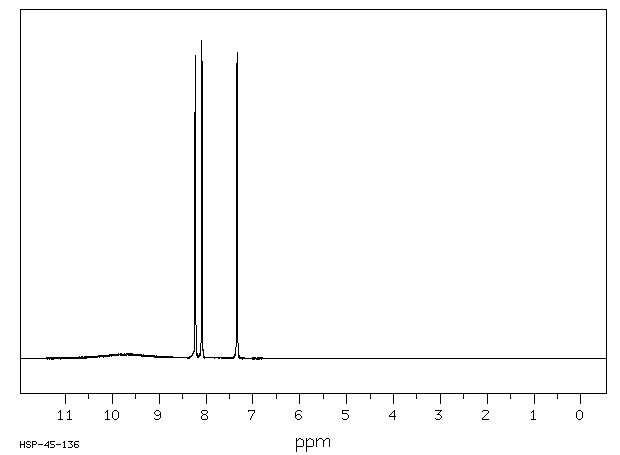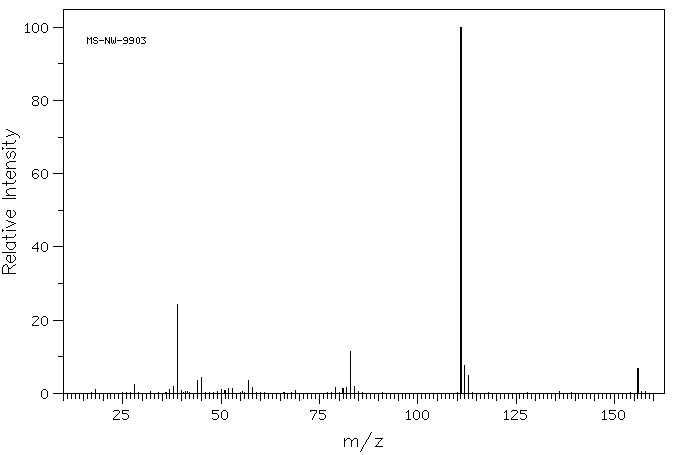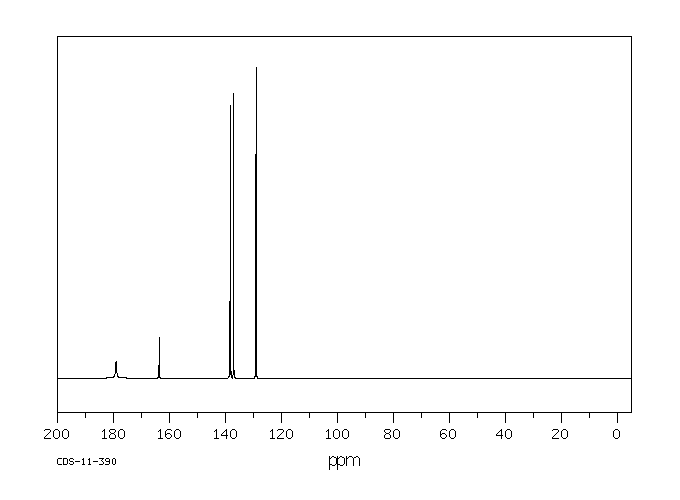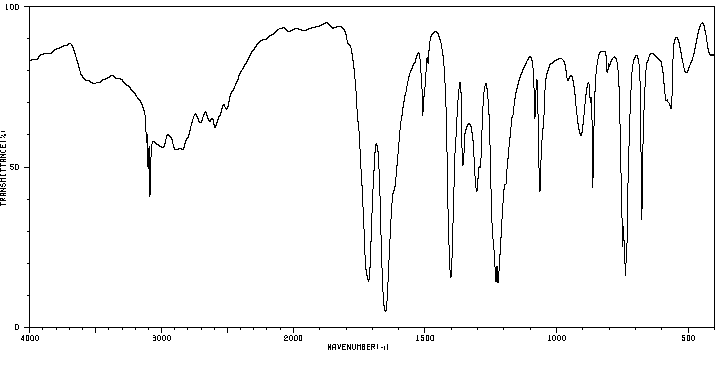2-噻吩乙醛酸 | 4075-59-6
中文名称
2-噻吩乙醛酸
中文别名
2-噻吩甲醯甲酸;噻吩-2-乙醛酸
英文名称
2-thiopheneglyoxylic acid
英文别名
2-oxo-2-(thiophen-2-yl)acetic acid;2-oxo-2-thiophen-2-ylacetic acid
CAS
4075-59-6
化学式
C6H4O3S
mdl
——
分子量
156.162
InChiKey
GIWRVUADKUVEGU-UHFFFAOYSA-N
BEILSTEIN
——
EINECS
——
-
物化性质
-
计算性质
-
ADMET
-
安全信息
-
SDS
-
制备方法与用途
-
上下游信息
-
文献信息
-
表征谱图
-
同类化合物
-
相关功能分类
-
相关结构分类
物化性质
-
熔点:88-91 °C (lit.)
-
沸点:250.38°C (rough estimate)
-
密度:1.404 (estimate)
-
稳定性/保质期:
计算性质
-
辛醇/水分配系数(LogP):1.1
-
重原子数:10
-
可旋转键数:2
-
环数:1.0
-
sp3杂化的碳原子比例:0.0
-
拓扑面积:82.6
-
氢给体数:1
-
氢受体数:4
安全信息
-
危险等级:8
-
危险品标志:C
-
安全说明:S26,S27,S28,S36/37/39,S45
-
危险类别码:R34
-
WGK Germany:3
-
海关编码:2934999090
-
危险品运输编号:UN 3261 8/PG 2
-
包装等级:III
-
危险类别:8
-
危险标志:GHS05
-
危险性描述:H314
-
危险性防范说明:P280,P305 + P351 + P338,P310
-
储存条件:请将药品存放在避光、通风干燥的地方,并密封保存。
SDS
| Name: | 2-Thiopheneglyoxylic acid 97% Material Safety Data Sheet |
| Synonym: | alpha-Oxo-2-thiopheneacetic acid |
| CAS: | 4075-59-6 |
Synonym:alpha-Oxo-2-thiopheneacetic acid
Section 2 - COMPOSITION, INFORMATION ON INGREDIENTS
| CAS# | Chemical Name | content | EINECS# |
| 4075-59-6 | 2-Thiopheneglyoxylic acid | 97 | 223-794-2 |
Risk Phrases: 36/37/38
Section 3 - HAZARDS IDENTIFICATION
EMERGENCY OVERVIEW
Irritating to eyes, respiratory system and skin.Hygroscopic (absorbs moisture from the air).
Potential Health Effects
Eye:
Causes eye burns. May cause chemical conjunctivitis and corneal damage.
Skin:
Causes skin burns. May cause skin rash (in milder cases), and cold and clammy skin with cyanosis or pale color.
Ingestion:
Causes gastrointestinal tract burns. May cause perforation of the digestive tract. May cause cardiac disturbances. May cause central nervous system effects. May cause systemic effects.
Inhalation:
Inhalation of high concentrations may cause central nervous system effects characterized by nausea, headache, dizziness, unconsciousness and coma. Causes chemical burns to the respiratory tract. Aspiration may lead to pulmonary edema. May cause cardiac abnormalities. May cause systemic effects.
Chronic:
Effects may be delayed.
Section 4 - FIRST AID MEASURES
Eyes: Get medical aid immediately. Do NOT allow victim to rub eyes or keep eyes closed. Extensive irrigation with water is required (at least 30 minutes).
Skin:
Get medical aid immediately. Immediately flush skin with plenty of water for at least 15 minutes while removing contaminated clothing and shoes. Wash clothing before reuse. Destroy contaminated shoes.
Ingestion:
Never give anything by mouth to an unconscious person. Get medical aid immediately. Do NOT induce vomiting. If conscious and alert, rinse mouth and drink 2-4 cupfuls of milk or water.
Inhalation:
Get medical aid immediately. Remove from exposure and move to fresh air immediately. If breathing is difficult, give oxygen. Do NOT use mouth-to-mouth resuscitation. If breathing has ceased apply artificial respiration using oxygen and a suitable mechanical device such as a bag and a mask.
Notes to Physician:
Treat symptomatically and supportively.
Section 5 - FIRE FIGHTING MEASURES
General Information:
As in any fire, wear a self-contained breathing apparatus in pressure-demand, MSHA/NIOSH (approved or equivalent), and full protective gear. During a fire, irritating and highly toxic gases may be generated by thermal decomposition or combustion. Contact with metals may evolve flammable hydrogen gas. Containers may explode when heated. Non-combustible, substance itself does not burn but may decompose upon heating to produce corrosive and/or toxic fumes.
Runoff from fire control or dilution water may cause pollution.
Extinguishing Media:
Do NOT use water directly on fire. Use water spray to cool fire-exposed containers. Use foam, dry chemical, or carbon dioxide.
Section 6 - ACCIDENTAL RELEASE MEASURES
General Information: Use proper personal protective equipment as indicated in Section 8.
Spills/Leaks:
Vacuum or sweep up material and place into a suitable disposal container. Clean up spills immediately, observing precautions in the Protective Equipment section. Avoid generating dusty conditions.
Provide ventilation.
Section 7 - HANDLING and STORAGE
Handling:
Use only in a well-ventilated area. Minimize dust generation and accumulation. Do not breathe dust, vapor, mist, or gas. Do not get in eyes, on skin, or on clothing. Keep container tightly closed. Do not ingest or inhale. Wash clothing before reuse. Discard contaminated shoes.
Storage:
Keep container closed when not in use. Store in a tightly closed container. Store in a cool, dry, well-ventilated area away from incompatible substances. Corrosives area. Store protected from moisture.
Section 8 - EXPOSURE CONTROLS, PERSONAL PROTECTION
Engineering Controls:
Facilities storing or utilizing this material should be equipped with an eyewash facility and a safety shower. Use adequate ventilation to keep airborne concentrations low.
Exposure Limits CAS# 4075-59-6: Personal Protective Equipment Eyes: Wear appropriate protective eyeglasses or chemical safety goggles as described by OSHA's eye and face protection regulations in 29 CFR 1910.133 or European Standard EN166.
Skin:
Wear appropriate protective gloves and clothing to prevent skin exposure.
Clothing:
Wear appropriate protective clothing to prevent skin exposure.
Respirators:
Follow the OSHA respirator regulations found in 29 CFR 1910.134 or European Standard EN 149. Use a NIOSH/MSHA or European Standard EN 149 approved respirator if exposure limits are exceeded or if irritation or other symptoms are experienced.
Section 9 - PHYSICAL AND CHEMICAL PROPERTIES
Physical State: Powder
Color: yellow to green
Odor: None reported.
pH: Not available.
Vapor Pressure: Not available.
Viscosity: Not available.
Boiling Point: Not available.
Freezing/Melting Point: 88.00 - 91.00 deg C
Autoignition Temperature: Not applicable.
Flash Point: Not applicable.
Explosion Limits, lower: Not available.
Explosion Limits, upper: Not available.
Decomposition Temperature:
Solubility in water:
Specific Gravity/Density:
Molecular Formula: C6H4O3S
Molecular Weight: 156.16
Section 10 - STABILITY AND REACTIVITY
Chemical Stability:
Stable at room temperature in closed containers under normal storage and handling conditions.
Conditions to Avoid:
Incompatible materials, dust generation, excess heat, strong oxidants, exposure to moist air or water.
Incompatibilities with Other Materials:
Moisture, oxidizing agents, strong bases.
Hazardous Decomposition Products:
Carbon monoxide, oxides of sulfur, irritating and toxic fumes and gases, carbon dioxide.
Hazardous Polymerization: Has not been reported.
Section 11 - TOXICOLOGICAL INFORMATION
RTECS#:
CAS# 4075-59-6 unlisted.
LD50/LC50:
Not available.
Carcinogenicity:
2-Thiopheneglyoxylic acid - Not listed by ACGIH, IARC, or NTP.
Section 12 - ECOLOGICAL INFORMATION
Section 13 - DISPOSAL CONSIDERATIONS
Dispose of in a manner consistent with federal, state, and local regulations.
Section 14 - TRANSPORT INFORMATION
IATA
Shipping Name: CORROSIVE SOLID, ACIDIC, ORGANIC, N.O.S.*
Hazard Class: 8
UN Number: 3261
Packing Group: III
IMO
Shipping Name: CORROSIVE SOLID, ACIDIC, ORGANIC, N.O.S.
Hazard Class: 8
UN Number: 3261
Packing Group: III
RID/ADR
Shipping Name: CORROSIVE SOLID, ACIDIC, ORGANIC, N.O.S.
Hazard Class: 8
UN Number: 3261
Packing group: III
Section 15 - REGULATORY INFORMATION
European/International Regulations
European Labeling in Accordance with EC Directives
Hazard Symbols: XI
Risk Phrases:
R 36/37/38 Irritating to eyes, respiratory system
and skin.
Safety Phrases:
S 26 In case of contact with eyes, rinse immediately
with plenty of water and seek medical advice.
S 37/39 Wear suitable gloves and eye/face
protection.
WGK (Water Danger/Protection)
CAS# 4075-59-6: No information available.
Canada
None of the chemicals in this product are listed on the DSL/NDSL list.
CAS# 4075-59-6 is not listed on Canada's Ingredient Disclosure List.
US FEDERAL
TSCA
CAS# 4075-59-6 is not listed on the TSCA inventory.
It is for research and development use only.
SECTION 16 - ADDITIONAL INFORMATION
N/A
制备方法与用途
上下游信息
-
上游原料
中文名称 英文名称 CAS号 化学式 分子量 阿地杂质1 methyl 2-thienylglyoxylate 26878-13-7 C7H6O3S 170.189 2-噻酚乙酯乙酸乙酯 ethyl 2-thienyl glyoxylate 4075-58-5 C8H8O3S 184.216 2-乙酰基噻吩 2-Acetylthiophene 88-15-3 C6H6OS 126.179 -
下游产品
中文名称 英文名称 CAS号 化学式 分子量 阿地杂质1 methyl 2-thienylglyoxylate 26878-13-7 C7H6O3S 170.189 2-噻酚乙酯乙酸乙酯 ethyl 2-thienyl glyoxylate 4075-58-5 C8H8O3S 184.216 —— allyl 2-thiopheneglyoxylate 135386-31-1 C9H8O3S 196.227 —— isopropyl-2-oxo-2-(thiophen-2-yl)acetate —— C9H10O3S 198.243 —— tert-butyl 2-oxo-2-(thiophen-2-yl)acetate 57200-08-5 C10H12O3S 212.269 —— Benzyl 2-oxo-2-thiophen-2-ylacetate 887641-79-4 C13H10O3S 246.287 —— (1-methyl-4-piperidyl)methyl-2-oxo-2-(2-thienyl)acetate —— C13H17NO3S 267.349 —— 4-diethylamino-1-methyl-2-butynyl α-oxo-2-thiopheneacetate 129927-73-7 C15H19NO3S 293.387 氧代(2-噻吩基)乙酰氯 oxo-thiophen-2-yl-acetyl chloride 4075-60-9 C6H3ClO2S 174.608 —— (+)-<(1S,2S,5R)-2-Isopropyl-5-methylcyclohexyl>-2-thienylglyoxylat —— C16H22O3S 294.415 —— 2-bromocyclohexyl 2-oxo-2-(thiophen-2-yl)acetate —— C12H13BrO3S 317.203 —— oxothien-2-yl-acetic acid 1-azabicyclo[2.2.2]oct-4-yl ester 320348-14-9 C13H15NO3S 265.333 噻吩偶姻 2,2'-thenil 7333-07-5 C10H6O2S2 222.288 - 1
- 2
反应信息
-
作为反应物:描述:参考文献:名称:三组分活化/炔基化/环缩合(AACC)合成增强的发射变色3-乙炔基喹喔啉摘要:可以通过三组分的连续活化-炔基化-环缩合(AACC)一锅法序列轻松合成2-取代的3-乙炔基喹喔啉生色团。与以前发表的从富电子的π-亲核试剂开始的四组分乙醛酸化作用相比,(杂)芳基乙醛酸的直接活化作用允许引入不能被乙醛化作用直接取代的取代基。通过引入N,N由于二甲基苯胺是2-位的强供体,因此3-乙炔基喹喔啉的发射溶剂变色性可以得到显着增强,以单个生色团在相对窄的极性窗口内覆盖从蓝绿色到深红色橙色的光谱范围。合成多组分反应概念的多样性导向性质使得可以通过Hammett相关性和Lippert-Mataga分析对结构-性质关系进行全面研究,并通过DFT阐明发射溶剂化变色π-共轭供体-受体系统的电子结构。具有PBEh1PBE功能的时间依赖性DFT计算可更好地再现最长波长吸收带的主要电荷转移特征。DOI:10.1002/chem.201800079
-
作为产物:参考文献:名称:Kroehnke, Chemische Berichte, 1947, vol. 80, p. 298,310摘要:DOI:
-
作为试剂:描述:参考文献:名称:Thiophenyl triazol-3-one derivatives as smooth muscle relaxants摘要:本发明提供了一种新型的[1,2,4]三唑-3-酮衍生物,其具有一般式(I),其中:Q为,R1、R2、R3、R4、R5和R6如本文所定义,或其无毒药学上可接受的盐或溶剂,它们是平滑肌松弛剂,并且在治疗对平滑肌松弛有反应的疾病,如哮喘、肠易激综合征、男性勃起功能障碍和尿失禁方面有用。公开号:US06613786B2
文献信息
-
Reductive Amination of Ketonic Compounds Catalyzed by Cp*Ir(III) Complexes Bearing a Picolinamidato Ligand作者:Kouichi Tanaka、Takashi Miki、Kunihiko Murata、Ayumi Yamaguchi、Yoshihito Kayaki、Shigeki Kuwata、Takao Ikariya、Masahito WatanabeDOI:10.1021/acs.joc.9b01565日期:2019.9.6Cp*Ir complexes bearing a 2-picolinamide moiety serve as effective catalysts for the direct reductive amination of ketonic compounds to give primary amines under transfer hydrogenation conditions using ammonium formate as both the nitrogen and hydrogen source. The clean and operationally simple transformation proceeds with a substrate to catalyst molar ratio (S/C) of up to 20,000 at relatively low
-
Primary Amines by Transfer Hydrogenative Reductive Amination of Ketones by Using Cyclometalated Ir<sup>III</sup>Catalysts作者:Dinesh Talwar、Noemí Poyatos Salguero、Craig M. Robertson、Jianliang XiaoDOI:10.1002/chem.201303541日期:2014.1.3Cyclometalated iridium complexes are found to be versatile catalysts for the direct reductive amination (DRA) of carbonyls to give primary amines under transfer‐hydrogenation conditions with ammonium formate as both the nitrogen and hydrogen source. These complexes are easy to synthesise and their ligands can be easily tuned. The activity and chemoselectivity of the catalyst towards primary amines
-
K<sub>2</sub>S<sub>2</sub>O<sub>8</sub> activation by glucose at room temperature for the synthesis and functionalization of heterocycles in water作者:Joydev K. Laha、Mandeep Kaur HunjanDOI:10.1039/d1cc03777c日期:——sulfate radical anion, the utilization of this protocol in organic synthesis is rarely demonstrated. We reinvestigated selected K2S2O8-mediated known organic reactions that invariably require higher temperatures and an organic solvent. A diverse, mild functionalization and synthesis of heterocycles using the inexpensive oxidant K2S2O8 in water at room temperature is reported, demonstrating the sustainability
-
Iron-Facilitated Oxidative Radical Decarboxylative Cross-Coupling between α-Oxocarboxylic Acids and Acrylic Acids: An Approach to α,β-Unsaturated Carbonyls作者:Qing Jiang、Jing Jia、Bin Xu、An Zhao、Can-Cheng GuoDOI:10.1021/acs.joc.5b00267日期:2015.4.3The first Fe-facilitated decarboxylative cross-coupling reaction between α-oxocarboxylic acids and acrylic acids in aqueous solution has been developed. This transformation is characterized by its wide substrate scope and good functional group compatibility utilizing inexpensive and easily accessible reagents, thus providing an efficient and expeditious approach to an important class of α,β-unsaturated
-
Asymmetric Organocatalytic Direct Aldol Reactions of Ketones with α-Keto Acids and Their Application to the Synthesis of 2-Hydroxy-γ-butyrolactones作者:Xiao-Ying Xu、Zhuo Tang、Yan-Zhao Wang、Shi-Wei Luo、Lin-Feng Cun、Liu-Zhu GongDOI:10.1021/jo701868t日期:2007.12.1of organocatalysts for the asymmetric direct aldol reactions of ketones with α-keto acids were designed on the basis of molecular recognition and prepared from proline and aminopyridines. The organic molecule 8e, derived from proline and 6-methyl-2-amino pyridine, was the best catalyst, affording excellent enantioselectivities (up to 98% ee) for the direct aldol reactions of acetone or 2-butanone with
表征谱图
-
氢谱1HNMR
-
质谱MS
-
碳谱13CNMR
-
红外IR
-
拉曼Raman
-
峰位数据
-
峰位匹配
-
表征信息
同类化合物
(反式)-4-壬烯醛
(s)-2,3-二羟基丙酸甲酯
([1-(甲氧基甲基)-1H-1,2,4-三唑-5-基](苯基)甲酮)
(Z)-4-辛烯醛
(S)-氨基甲酸酯β-D-O-葡糖醛酸
(S)-3-(((2,2-二氟-1-羟基-7-(甲基磺酰基)-2,3-二氢-1H-茚满-4-基)氧基)-5-氟苄腈
(R)-氨基甲酸酯β-D-O-葡糖醛酸
(5,5-二甲基-2-(哌啶-2-基)环己烷-1,3-二酮)
(2,5-二氟苯基)-4-哌啶基-甲酮
龙胆苦苷
龙胆二糖甲乙酮氰醇(P)
龙胆二糖丙酮氰醇(P)
龙胆三糖
龙涎酮
齐罗硅酮
齐留通beta-D-葡糖苷酸
鼠李糖
黑芥子苷单钾盐
黑海棉酸钠盐
黑木金合欢素
黑曲霉三糖
黑介子苷
黄尿酸8-O-葡糖苷
麻西那霉素II
麦迪霉素
麦芽糖脎
麦芽糖基海藻糖
麦芽糖1-磷酸酯
麦芽糖
麦芽四糖醇
麦芽四糖
麦芽十糖
麦芽六糖
麦芽五糖水合物
麦芽五糖
麦芽五糖
麦芽五糖
麦芽三糖醇
麦芽三糖
麦芽三糖
麦芽三塘水合
麦芽七糖水合物
麦芽七糖
麦法朵
麦可酚酸-酰基-Β-D-葡糖苷酸
麦利查咪
麝香酮
鹤草酚
鸢尾酚酮 3-C-beta-D-吡喃葡萄糖苷
鸡矢藤苷










